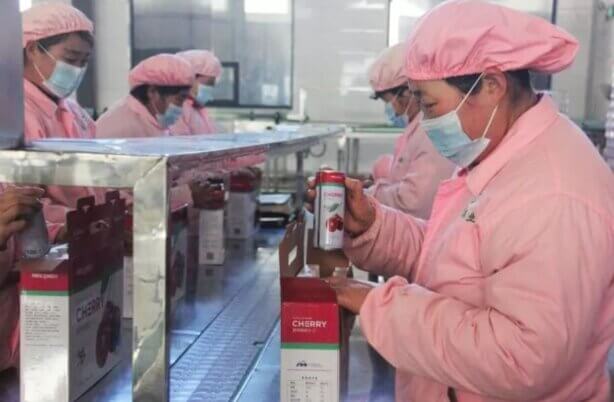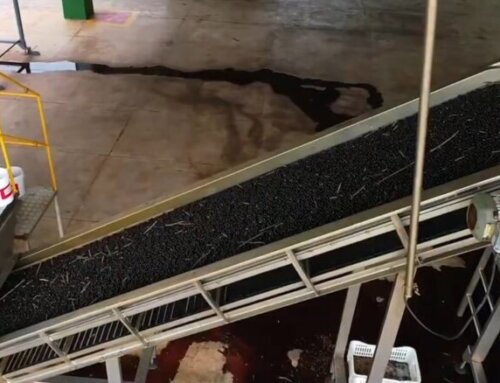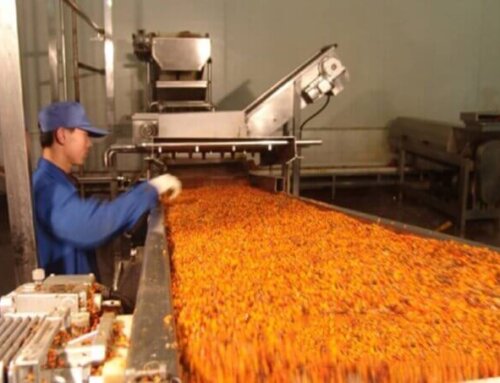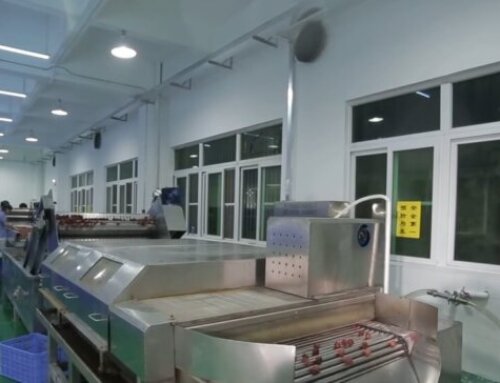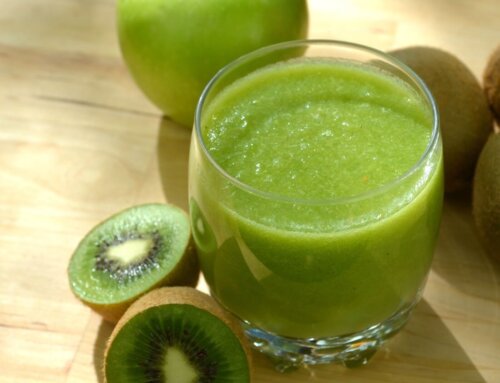Project Description
Cherry Processing Plant
Description Of Cherry Processing Plant
- Cherry fruits are divided into sweet cherry and tart cherry, widely planted in the Middle East, South Europe and North America. Turkey, the United States and Chile are the major cherry products processing countries.
- Cherry fruits are rich in sugar, protein, vitamins and calcium, phosphorus, iron, potassium and other elements, it has the effects of whitening skin, nourishing blood, strengthening the spleen and stomach.
- After pitting, pulping, enzyme treatment and centrifuge separating, fresh cherry fruits juice yield rate can reach 80%.
- The cherry processing plant mainly includes cherry washer and sorter, cherry de-stemmer and crusher, cherry preheating machine, cherry pitting and pulping machine, cherry pulp enzyme treatment, cherry juice separating machine, cherry pulp/juice evaporator, sterilizer and filler, CIP system and other public utilities, and all the cherry processing machines are made of SUS304 material to meet the food processing hygiene requirements.
- The capacity for the cherry processing line is from 1 ton per hour to 30 tons per hour. The cherry fruits can proceed into the aseptic puree, concentrated juice, cherry jam, canned cherry and dry cherry fruits according to clients’ different requirements, these end products can be filled into aseptic bags, bottles, jars, cans, and pouches.
Cherry Processing End Products And Package
Single Strength Cherry Puree: 14-20 Brix, the puree is obtained after fresh cherry washing, sorting, pitting and pulping, homogenizing and sterilizing and degassing, the end products will be filled into aseptic bags. The end products can be used as raw materials in fruit-based products (e.g., baby foods, jams, juices, fruit sauces, etc.)
Concentrated Cherry Juice: from 20 Brix concentrated to 68 Brix. PH value is 3.5-4.2. Cherry puree after enzymatic hydrolysis and decanter centrifuge separating, the cherry juice is obtained, then the juice will be evaporated by falling film evaporator, and then sterilized, then filled into the aseptic bag in drums.
Cherry Jam: Cherry puree mixed with sugar, acid and pectin to get the cherry jam, then after pasteurized and homogenized, it will be filled into the jars.
Canned Cherry: Canned cherries are heat-treated products, in which the fruits are appropriately prepared (washing, stem removal, with or without seeds) in sweet syrup. Besides fruits and sugar, these products may contain alcohol, vinegar, spices, plant particles (for coloring, sweetening, flavoring, and decoration), and other additives (e.g., citric acid and solidification agents).
RTD Cherry Juice/Nectar: Use cherry puree and concentrated cherry juice as raw materials, then mix and dilute with water and other flavor ingredients(sugar, acid), after pasteurizing, then filled into consumable containers(bottles, cans, cartons).

Cherry Processing Plant Technological Flowchart
Fresh cherry fruits will be fed into the air bubble washing machine to remove the foreigner matters, then after manually picking and sorting on the conveyors, the fresh cherry will be fed into the cherry de-stemmer and crusher, after that, the fruits will be preheated/precooked by tubular heat exchangers, then fed into the pitting and pulping machines to get the cherry puree.
The cherry puree can be filtered and homogenized, UHT sterilized and degassed, at last filled into the aseptic bags or pouches; If the end product is the cherry juice, then the cherry puree will be enzyme treatment and decanter separated, and after that, the cherry juice can be evaporated and sterilized, then filled into the aseptic bags; and the cherry juice can also made into NFC juice without concentrating, then sterilized and filled into small containers like bottles, cans or cartons.

Cherry Processing Plant Key Machine Introduction
Cherry fruit washing and sorting machine
The preparation of the fruits begins with a washing step, which is usually performed in a water bath. Fruit washing efficiency can be successfully improved by water circulation and air bubbles. Then is followed by a selection and sorting on the belt conveyors, where extra attention is paid to sorting out moldy and deteriorated fruits. Microorganisms and their metabolites can cause quality problems if they get into the end products.


Cherry fruit de-stemmer and crusher
The machine can remove the stems on the cherry fruits, and at the same time it is broken up. It is made of SUS304 material and has a high working efficiency. The cherry fruit stems can also be removed manually, if that, here will be equipped with a hammer crusher to crack the fruits into the mash.
Cherry fruit preheating machine
The cherry mashes are preferred with thermal and enzymatic treatments by a tubular preheater. Thermal treatment means heating the crushed cherry fruits up to 80–85℃ and keeping the temperature for 5 minutes, then cooling to room temperature. This short-heat treatment inactivates the enzymes, cell walls become permeable, and color pigments in the skin and under the skin can be extracted to a higher extent.
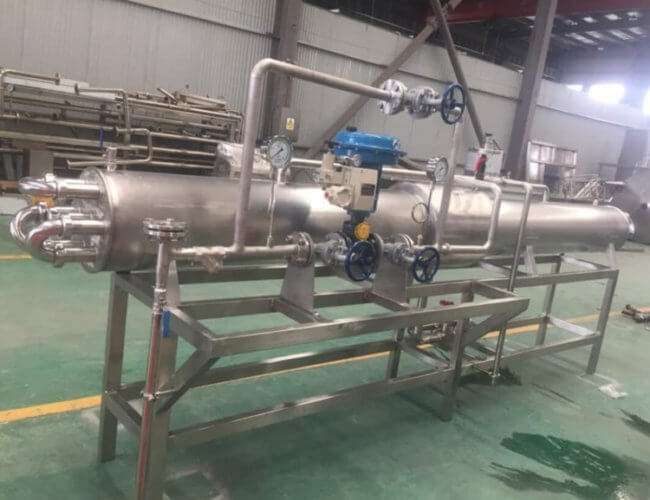
Cherry fruit pitting and pulping machine
The double stage pulping machine can remove the cherry core and skin to get the cherry puree. The pulping devices apply centrifugal force on the fruit, so the fruit pulp passes through the perforated sieve surface, meanwhile, harder skin and seed particles are retained by the sieve. To improve the efficacy and decrease losses, separation is performed gradually by using sieves of decreasing pore size. Generally, fruit flesh is pressed first in a coarse (1.2mm) and then in a fine (0.6mm) perforation sieve. The first step removes the majority of the fruit skin and seeds, the second step removes the coarse fiber in the fruit pulp.

Cherry juice enzymatic hydrolysis and juice separating machine
The addition of pectolytic enzymes to the cherry mash is widely used to improve the juice yield rate, where mainly the water-soluble pectin are decomposed. These enzyme products are PTE (polytranseliminase) and PG (polygalacturonase) content. Although this process can be performed at 45–55℃, enzymatic pretreatment can also work between 10℃ and 30℃. The time for this treatment, before juice extracting, is about 30–60 minutes.
After the enzymatic hydrolysis process, the material will be pumped into the centrifuge separating machine.
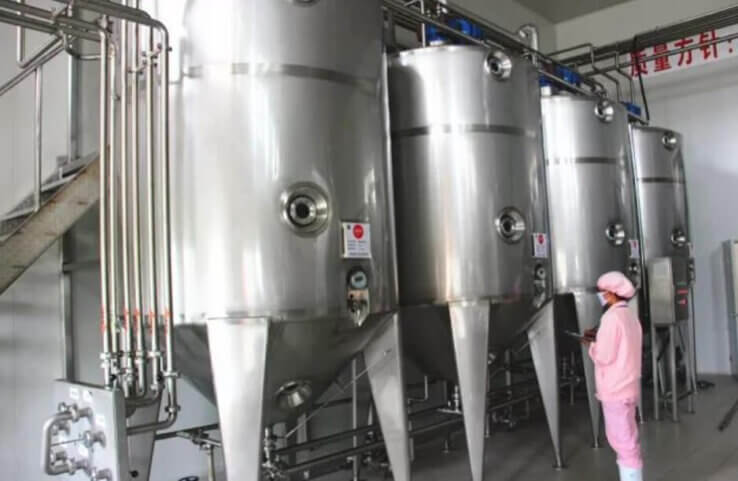
Cherry juice/pulp homogenizing sterilizing and degassing machine
In order to achieve homogenous, smooth, creamy, texture and slow the settlement of formal particles, fruit pulp/juice is homogenized. This step leads to increased virtual viscosity within the system and more consistent pulp/juice.
During pulping, some air enters the fruit puree. Due to the fine particle size, this can lead to non-desired oxidation on an increased surface. This air can also ruin the effectiveness of the pasteurization equipment, thus aeration of the fruit pulp is recommended directly after homogenization. Deaeration is usually performed in a special tank that is under vacuum, where the fruit pulp enters by spraying.
The cherry juice/pulp sterilizing temperature will depend on the filling temperature and the end products produced. If the cherry puree and concentrated juice are filled into the aseptic bags, then it will need UHT sterilized for the products, the sterilizing temperature will be about 115-125℃ holding for 15-30S; If the juice or jam is hot filling into bottles or jars, then the products will be pasteurized at 90-95℃and holding for 2-3mins.

Cherry juice/pulp filling machine
Concentrated cherry pulp can be filled into 220L aseptic bag in drum fillers and bag in box fillers for B2B use, single strength cherry puree can be filled into consumable pouches for baby food.
Cherry juice will be hot-filled into bottles or cans for direct consumption, and some manufacturers will also fill the cherry juice into cartons at room temperature.
Cherry jam can be filled into glass jars or cans, after filling, the liquid nitrogen can be dosed into the container to make the final products with longer shelf life.

